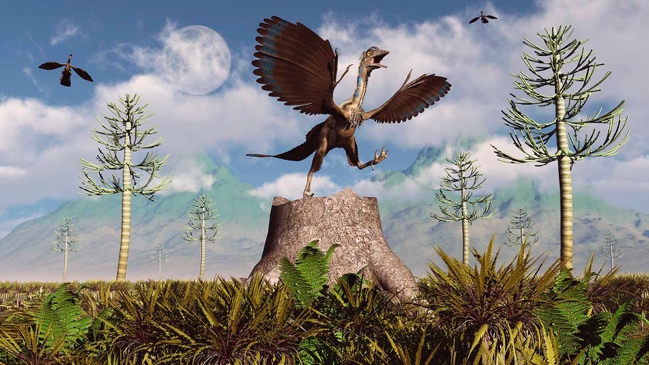
General Information
The systematic position of the feathered dinosaur Archaeopteryx, which was the size of a modern crow, is still questioned. This animal looked like a typical representative of reptiles; it had dry skin and long claws: in addition, Archaeopteryx lived at the same time as other dinosaurs, as the period of its existence is defined as 150 million years ago. At the same time, Archaeopteryx had the ability to fly, plumage, and size of modern birds, so this animal is often considered a direct ancestor of birds. Analysis of wing bone structure shows that Archaeopteryx was capable only of gliding flight, which means that most of the time, the dinosaur lived on the ground or in trees. Archaeopteryx was a typical predator: small prey was grabbed with non-rigid jaws, and to hunt larger game, the feathered dinosaur used long claws on the end of its limbs.
Skull structure
The skull structure of Archaeopteryx resembles that of most small Jurassic lizards or some birds. The lower jaw of the bird was movable, and both the lower and upper jaws were pierced with small conical teeth. The pre-mandibular bones were not fused, which gave Archaeopteryx excellent mobility of the lower jaw. There is a sizeable occipital opening on the backside of the skull, necessary for connection with the spine. It is known that this dinosaur had no beak. It is also noteworthy that the brain of Archaeopteryx was more similar in volume to that of birds than reptiles: this includes the cerebellum. The eyeballs were located on the sides of the skull, so the animal could not clearly see the object in front of it.
Structure of the postcranial skeleton
The overall size of the dinosaur-bird did not exceed 60 centimeters in length and 1-2 kg in weight. The structure of its lower extremities was characteristic of birds: The animal had an opposable thumb that allowed it to balance on the ground. At the same time, Archaeopteryx was also characteristic of dinosaurs because one of the fingers of the hind limb had a long claw. The forelimbs were also developed and had three separated toes. The tail of the bird consisted of 23 vertebrae, which allowed the animal to effectively balance its body while moving, as was the case with the T-Rex. There were no small hooks in the thoracic spine, which means the bird was cold-blooded. It is also interesting that, as such, the clavicles and the animal were absent as they fused into a single complex bone.